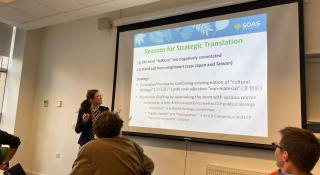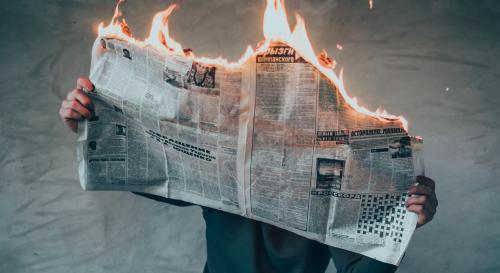
Breadcrumbs navigation
Un-suturing Westphalian IR via non-Western literature: A Grey Man (1963)
Young Chul Cho and Jungmin Seo discuss the key points from their new Review of International Studies (RIS) article. The article aims to un-suture common-sense assumptions based on Westphalian International Relations (IR) from South Korea’s non-essentialist and situated perspective, in the context of decolonising IR. Towards this end, the paper methodologically investigates a South Korean novel, A Grey Man, published in 1963 during South Korea’s early post-colonial period at the height of the Cold War. Using a non-Western novel to conduct a contrapuntal reading of Westphalian IR, this paper constructs a different type of worlding, conceptualising ‘the international’ through ‘the cultural’. In so doing, this paper attempts to access different IR words to think with, such as race, white supremacy, intimacy without equality, sarcastic empathy, and disengagement. These provide an arena in which we can think otherwise, while un-suturing dominant Westphalian IR thinking.
(Westphalian) IR as the white gaze in A Grey Man (1963)
A Grey Man makes it explicit that “We [Koreans] are a defeated race. The circumstances are simple. We have been colonial denizens for centuries. The East has been pulled before the light of world history as the slave of the West, not as an equal competitor. […] The idea that to Westerners we are merely yellow negroes … We awoke to find ourselves natives. In the old days, when the Westerners came to Africa they hunted elephants for ivory and they shipped the natives to America in chains for use as slaves. We are now negroes driven out to hunt in our own locale.”
This paper’s contrapuntal reading of the Westphalian international system via A Grey Man reveals that IR signifies interracial relations underpinned by white supremacy, rather than international relations. In this sense, the Westphalian international system is the white (controlling) gaze, which prevents us from seeing what is really present in IR, including race, racism, colonialism, imperialism, Orientalism, exclusion, inequality, and violence. In particular, race and racism, which have been silenced in IR, should be treated as central concerns in global life.
How do ‘yellow negroes’ make sense of themselves and their roles and life-modes in a world defined for them by the white West?
A Grey Man once states that “We [Koreans] are like laborers called out to push up a stone the Westerners had rolled down. What’s more, we aren’t even allowed to lay hands on the stone, we can only push Sisyphus’s butt. There are some people who miscomprehended this. And so they rack their brains wondering why the stone feels mushy or why a smell of farts is in the air. A myth based on a misunderstanding. The Westerners may be Sisyphuses, but we are not. We are something like ‘Sisyphus’s ass-pushers’. So our sufferings do not find expression in the lofty ordeals of Sisyphus. Rather, we always look bewildered, awkward, embarrassed, uncertain and indecisive.”
Korea became a yellow negro when the East was called up by the West through the expansion of Westphalian IR. For Koreans and people in the East, the modern world was defined for them, not by them. Yet that world has been co-constituted by both the white West as the master race and people of colour as subject races. Yellow negroes seem to have certain modes of being-in-the-world that place them at risk of violence, exploitation, and dehumanisation. First, subject races tend to unwittingly accept that the master race is an ontological condition for the existence of them. Yellow negroes are ‘I’, but that ‘I’ is an auxiliary ‘I’ that cannot come into being without the Cartesian ‘I’ – the white West. Second, subject races easily become seen as a means rather than an end in human history, from their own perspective, as well as that of the master race. Third, subject races lose the ability to see themselves except through the revelation of the master race. Subject races are enslaved to their own inferiority, just as the white West is enthralled by its own superiority. After all, the yellow East is essentially a lackey who wants to be (and therefore mimics) the Western master. At best, the lackey gets intimacy without equality with the white West. This implies self-inflicted alienation, despair, resignation, and self-abasement, all of which assist the coloniser in governing the colonised.
How does A Grey Man make sense of the white West, which is hegemonic in world history and politics?
The main protagonist in the novel says that “It would have been grand if our nation had had colonies. First of all, the outrageous number of college graduates now infesting the ranks of officialdom could be reduced by dispatching many to the various colonies. The anxiety and tension now current in the younger generation would thus be greatly abated and the social atmosphere in general would accordingly become far more congenial. […] No matter how bellicose the National Assembly can be with its ins and outs, once the agenda concerns colonial rule the opposed parties will forthwith suppress their disagreements and exhibit excellent examples of how the race is a bond of common interests in spite of everything. […] no life is more delectable for a race than one spent applying the screws to other races. Such pastimes provide breathing space from domestic political quarrels. […] Where on God’s green earth could we [Korea] possibly seize a colony for use as an essential fertilizer for the growth of democracy? Democracy without a colonial dominion certainly imposes great risks. […] Western humanism did exist but there never existed any humanism in general. […] Roses never bloom in a trash can. But Democracy blooms in the act of rape. […] Just as British capitalism alleviated its internal social contradictions, overcame crises and regained its vitality through well-managed colonialism, Christianity, encountering a cul-desac in the West, has alleviated its crises through so-called missionary work.”
What the novel does is to empathises with the imperial, hegemonic colonizer sarcastically. A Grey Man’s questionings do not imply that Western liberal values should be denigrated and rejected in full, but rather, that those values are a critical human heritage that can be liberating for the colonised and marginalised. To achieve this, it is necessary to shake up settled Western liberal assumptions and think from the perspective of those who are excluded and exploited by the white West’s enterprise of liberal democracy and capitalism, backed by colonialism and imperialism in practice. It is necessary not to reject but to critically appropriate Western ideas for and by colonial subalterns, while debunking the imperial practice of the ideas in human history.
In what ways does the protagonist of A Grey Man resist, engage with, and relate to the hegemonic West, which he has already internalised?
A Grey Man says that “What’s more, there is not even a tradition worth going back to. No, we do have one, but that tradition in nine out of ten cases turns out to be a trap from which there is no escape. […] Come the Revolution, will this suffering vanish? … A utopia of the Orient, what good would it do me then? […] Whatever may become of Korea, in truth I don’t care in my heart of hearts.”
This non-nationalist, egoistical stance reflects A Grey Man’s grim understanding of Korea’s international and domestic environments. In the novel, Korean society ‘is bounded by cliffs on all sides, regardless of one’s goals’. At the same time, ‘the Western brats are sure to meddle’ with Korean matters during the revolution. In this respect, revolutionary, elitist projects of essentialist nationalism are ‘sad illusions’ and ‘impossible tasks’. At the same time, mimicking Western universalism is not an option. At one point, A Grey Man mentions that ‘I will not become a Don Quixote [essentialised nationalism against the West], I will not become a native woman aping a missionary’s wife [mimicry of Western universalism]. […] This damn world we live in is full of traps. […] I decline to be in that script.’ By mimicking Western universalism, yellow negroes end up becoming ‘irresponsible epigones’ or ‘slavish mimics’, who can only have ‘intimacy without equality’ with the white West.
Viewed in this way, A Grey Man argues that “Dear beloved race. We are not heroes. We are not Sisyphuses. […] I can’t stand those shitasses. So I remain a spectator. Our stone. There is no such thing. It’s only a delusion we have. […] Then, what is to be done? What is to be done? There is nothing. Nothing. How to refuse to be a native? How not to become a giraffe? How not to be inhabitants of a reservation? What is to be done? … To gain the whole world, for we ourselves to become Westerners without delay, is that salvation? But we cannot become Westerners, either. By the time we’ve become Western, the West will have become something else. […] Instead of endlessly pursuing that illusion, let’s just flop down where we are. At least. Let’s think of some entirely different solutions. Let’s find a way to reverse the endless race between Achilles and the Tortoises. This Tortoise, in other words, should just sit down.”
Rather than kowtow and mimic the West or adopt an essentialised nationalism directed against the West, A Grey Man opts to disengage from the colonial script of Western dominance. This stance is a critical living attitude more than a theory. Disengagement has revolutionary potential as an act of resistance. It implies that the colonised do not see the imperial West as the universal reference point. It disturbs the world’s hegemonic pecking order. It threatens privilege and power. This is not to say that colonised people seek to reverse the existing relationship (superior West vs. interior East). Instead, disengagement helps colonised people create non-hegemonic spaces, in which different ways of thinking, doing, and relationship between diverse actors in the world. Note that, although colonised people try to detach from the imposing normative scripts of colonisation through disengagement, such disengagement is not surrender. Rather, it re-engages with another life-world register. In doing so, the disengagement approach should also consider post-colonial Western and post-white conditions in the white West. Disengagement also creates problems for the coloniser, as colonised people refuse to accept their role as the inferior other in a (neo)colonial world. The colonisers’ status and order become contested unless they can co-opt the inferior colonised. In this way, the colonised can exhaust the coloniser. Disengagement resists the logic of conquest and conversion employed by the coloniser. It therefore plays a role, not only in decolonising its ‘past’ and ‘present’, but also in preventing the colonisation of its ‘future’.
Conclusion: on decolonising IR
In relation to theory/theorisation, the goal of decolonising IR appears to need two-way processes. The first process involves un-suturing hegemony and totalising IR discourses, particularly those seen from below. It enables us to examine the hegemony’s invisible – yet hypervisible – hypocrisy and violence, while at the same time it empowers the subaltern’s agency and ability to detect and make critical sense of the colonial script of hegemony. This decolonial exercise is necessary but insufficient. Subaltern literatures, often cultural, which are rarely recognised by IR students with mainstream textbook training, must be excavated, celebrated, re-enunciated, and reinterpreted – not simply to correct our understanding of hegemonic culture, but also to revive a non-coercive and non-hegemonic language.
Want to know more? You can read the full article at DOI: https://doi.org/10.1017/S0260210523000712
BISA members receive access to RIS (and to our other journal European Journal of International Security) as a benefit of membership. To gain access, log in to your BISA account and scroll down to the 'Membership benefits' section. If you're not yet a member join today.


